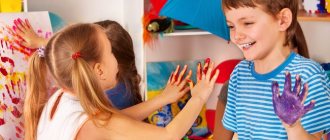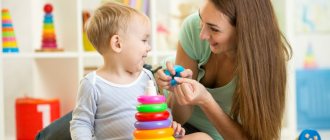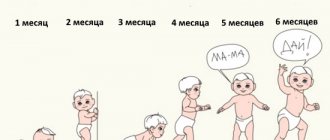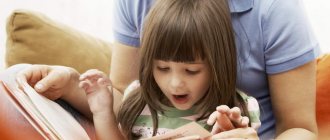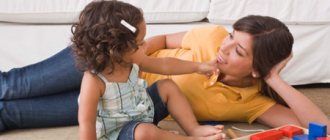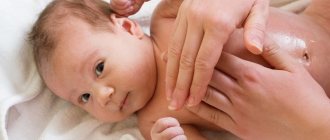A child’s speech at 1 year of age depends on how the preparatory work for its development was carried out from birth to one year. Humming, babbling and pronouncing the first words prepared the articulatory apparatus for more complex work; the baby's acquaintance with the objects of his immediate environment enriched his passive vocabulary.
At the age of one year, the baby already knows the meanings of many words, the active dictionary contains 10–25 words, and he begins to use speech as a means of communication. He can pronounce words correctly (mama, lalya, baba), babble (pa, ma, bah), partially reproduce the forms of words (“kach” - swing, “zya” - impossible), and imitate the voices of animals and the sounds around him (mu -mu, boo-boo, pee-pee, beep).
At this stage, it is already possible to determine whether there are speech problems. Unlike specialists, it can be difficult for parents to see them, but below we will tell you what signs you can use to independently identify speech problems in your baby.
Passive and active vocabulary
During this period, attention is drawn to such a characteristic feature as imitation of the words of adults. The baby repeats not only familiar words, but also previously unknown ones. These could be words addressed to the child, or words that he heard from others. Such active imitation can be noticed already from 1 year 5 months. Here it is important not to coo with children, faking your speech in “childish” language, but to give an example of the correct pronunciation of words.
Starting from the first year of life, the understanding of words grows; the baby is familiar with the names of objects in his immediate environment, the names of objects, animals and other objects that are most often shown to him in pictures in children's books, on the street. The baby loves to look at bright colored book illustrations. Adults should maintain this interest by choosing clear pictures.
When commenting on illustrations to a child, you need to speak precisely, in simple words, try to denote the object with one, constant word, so that the meaning of the picture is not lost in the stream of speech of an adult. For example, while the word monkey is used to describe monkeys and gorilla.
By the age of one and a half years, a child’s active vocabulary is 20–30 words; its sound composition is still simple. Thanks to the desire to imitate the speech of adults, by the end of the second year the baby increases the number of spoken words tenfold. Speech is dominated by nouns, but there are also verbs (2-3 times less of them) and adverbs (there, here, here).
Occasionally, by the age of two, the use of adjectives can be found in children's speech; this feature will continue to persist into early preschool age. Personal pronouns are often found in a child’s speech and are easily used (I, you, he, she).
How does a child's speech develop before one year of age?
The baby begins to master and make the first sounds at 3 months. As a rule, the sounds that come easiest during this period are n, k, g. A six-month-old baby understands familiar words from adults, reacts to them, and pronounces the first syllables: ma, ba. By 8 months, speech develops to more complex sounds: p, b, m, a, e, k, g. The baby tries, with the help of adults, to form syllables from these letters: pa, ba, ma, gu. Walking becomes the first example of speaking.
Until one year of age, children have a more developed emotional side of speech. They watch the lips and faces of adults, remember every sound, its pronunciation, and emotional coloring. Baby babble appears around the age of one year, when the baby begins to say the first words: mom, dad, give, lalya, na, zya (you can’t), di (go). The one-year-old baby understands the phrases “you can’t”, “come to me”, “crawl”, “go”, “kiss mommy”.
Grammatical structure of speech and sound pronunciation
After one and a half years, the ability to change words in the simplest ways appears, linking them into one phrase (give me a doll - “give me a ku”). Monosyllabic sentences are most often used. In such primitive sentences, one word can be used in different meanings. By pronouncing the word “mu,” in one case the child wants to be given a toy, and in another, with the same word, he draws the adult’s attention to the eyes or horns of the toy cow that he is holding in his hands.
By the end of the second year of life, sentences may contain three or four words. Sentences can be both interrogative and exclamatory. The question words themselves are not yet available to the child; he expresses the question by the intonation with which he pronounces such a sentence. There are no prepositions in the words yet either (“Seva bi-bi” - Seva has a typewriter).
All vowel sounds are already pronounced by the baby in the second year of life. Its articulations and some consonant sounds are available: m, p, k, t, d, n, f, x, b, g, v, y. The clarity of their pronunciation depends on the place of the sound in the word and the number of syllables in it. In simple words of one or two syllables, all sounds are pronounced correctly (Katya, dad, Tanya, Vova). These same sounds are “swallowed” and distorted in more complex words (pisina - machine). Combinations of two consonant sounds next to each other (heb - bread) are also difficult for the baby, especially if these are sounds that are difficult to pronounce, for example: s, sh, r, l.
Different rates of speech acquisition by children of the same age become noticeable. This depends on the individual characteristics of the baby, heredity, and diseases suffered in early childhood. Of great importance is the intensity of communication between adults and the child, how the child’s speech development is stimulated at 1 year of age.
Speech therapist advice
In order for your baby to master the speaking process earlier and quickly move from babbling to full understandable words, it is necessary to follow a number of rules:
- Do not talk for a long time, copying the speech of a baby (yeah, yeah). As soon as the baby begins to master the first words, you should stop baby talk and speak correctly.
- The pacifier should be removed from use after 1 year, maximum 1.5. It slows down speech development, prevents you from speaking more, even a child’s crying is part of speech.
- Encourage your baby to blow the whistle, blow soap bubbles, and play whistles, which stimulates the development of the articulatory apparatus.
- Play the “monkey” game with the baby, when he must repeat various grimaces after the parent: puff out his cheeks, suck in his lips, smile, etc.
- Do more modeling, drawing, and cutting with your child. Let the baby glue, rearrange, move, and collect various objects. The parent’s task is to pronounce the shape, color, and sound.
- Teach children to express their own emotions through speech, even if initially these are simple words: oh, yes, yeah, uh.
- Read more fairy tales. It is better to choose books with bright illustrations. It is difficult to keep a child under 2 years old in one place for a long time and listen to a fairy tale to the end. Colorful pictures will help you concentrate, listen to an adult read, and follow the story.
A child’s speech is formed before the age of 3. Until this age, children are not required to read poetry aloud, but they must begin to speak at the age of one. Each baby is individual, speech development is a process that is easier for some to comprehend and more difficult for others. It is important not to lose hope, to work with children from birth to one year, to actively talk with the baby, read fairy tales, and play. Joint activity with an adult is a powerful stimulus for the development of speech activity.
Norms of speech development in the second year of a baby’s life
Assessing a child’s speech at one year of age is very problematic: the guidelines for its development are very arbitrary and a delay in speech activity is acceptable. You can give approximate norms at the end of the second year of life:
- the baby answers simple questions;
- he can carry out a simple order, for example, take a cup to his grandmother, give him an item or a toy;
- the child easily repeats simple phrases and simple words after adults;
- all vowels and most consonants are available to its pronunciation;
- by the age of one and a half years, the baby combines two words into a sentence, and by two years, he constructs a sentence of 3–4 words;
- he actively and on his own initiative enters into communication with other children and familiar adults;
- he can ask a question using intonation;
- the child is able to pronounce at least 50 words, more often 200–300;
- begins to use singular and plural nouns (cube - cubes), diminutive suffixes (house - house);
- he can understand and follow two-step instructions: “Take the spoon on the table and take it to dad”;
- the baby can show two or three parts of the body or more;
- listens to nursery rhymes, fairy tales, poems, tries to remember small pieces.
If in the list above you see an item that your baby does not meet, it is worth closely observing the child, assessing whether he strives to communicate with others, whether he understands speech addressed to him. It is possible that the baby has a slight delay in speech development.
How to develop a child's speech at 1 year old
At one year of age, you can promote the child’s speech development with the help of special exercises. Every parent can conduct them. Developmental exercises are based on games, songs, reading poems and fairy tales.
Games for speech development
During any game, you need to pay attention to the signs and features of objects, and pronounce them out loud. You should choose games where you need to repeat words after an adult, sing a song, recite a rhyme, or complete a simple task.
- Drawing. The lesson is useful at any age, it trains hand motor skills, the development of thinking processes, memory, and attention. You can draw anything, the main thing is to tell children about the drawn object, what parts it consists of, what color is best to paint each element. During the game, you can tell funny rhymes, for example, when animals are depicted.
- Pyramid. 70% of children have the game, but not every parent plays it correctly with their child. Assembling the pyramid consists of several stages. First, the parent shows an example of collection, pronounces one feature of the object - color: “we put a red ring on a yellow one, a blue ring on an orange one, etc.” Then you need to invite the child to put the pyramid together. The next stage is putting the pyramid together, pronouncing not only the color, but also the shape, size of the object - round, rectangular, triangular or square, large, small, huge, medium.
- As the animals say. All children like this game about animals. It is important not just to pronounce animals and the peculiarities of their speech, but also to include cubes, drawings, and cards in the game so that the child can simultaneously find the desired animal or bird. The game is easy to use and is based on a dialogue with the baby: “What does the chicken say?” The kid answers: “Ko-ko.”
− “What does the goat say?”
− “Be-be.”
− “What does the frog say?”
− “Kwa-kwa.”
A 1 year old baby will not immediately pronounce all the syllables, it is important to help him. This is what learning to speak is all about.
Symptoms of delayed speech development in a baby
How to understand that a one-year-old child has a delay in speech development? This question interests many parents, and often moms and dads rush from one extreme to another. Some, seeing how their child’s peers express themselves fluently and freely, anxiously listen to the speech of their child, who has not mastered even half of this vocabulary. Others, relying on the stories of those who tell how their silent children suddenly spoke at 3, 5, 6 years old, do nothing and wait for the same miracle, and then face the problem of a serious delay in the development of their baby.
The age from one to two years is a kind of milestone when it becomes clear whether a child’s speech is developing normally, or whether the child has one of the following pathologies:
- motor alalia
- sensory alalia,
- dysarthria,
- aphasia,
- rhinolalia,
- hearing loss, or lack of hearing,
- delayed speech development,
- general speech underdevelopment.
At two years old, it is necessary to have your baby examined by a specialist if he has the following symptoms:
- the child is silent or babbles in one language he understands;
- when asked what his name is, he turns away;
- the baby does not turn to an adult when he needs something, but hums or points with his finger;
- the child understands what is said to him, but cannot formulate the statement himself;
- at first speech appeared, there were words or even phrases in it, and then it disappeared, and the child practically fell silent;
- by 2 years of age there are almost no words in speech.
Based on the results of the examination, at two years of age it is advisable to begin stimulating speech development, and parents themselves can make significant progress in this direction. Many simply do not know what and how to do, so it is recommended to go for a consultation with a speech therapist, psychologist or defectologist - you can work with them from the age of 2.
First word
What should a baby's first word be? Early development specialists believe that it does not necessarily have to be familiar and familiar to us. Experts tend to consider any recognizable set of sounds that denote a person, object or action (for example, “baka” instead of “dog”, “ka” instead of “porridge”) as a peculiar word.
Usually children say their first word at the age of 8-9 months. Most often these are onomatopoeias or words of two repeated syllables.
How to understand that a child said exactly a word, and not just a set of sounds? If the child’s statements are repeated under the same circumstances, even if you cannot understand them, rest assured that your baby said a word, his speech apparatus is simply not yet developed enough to pronounce this word legibly. To prevent your child’s speech development from slowing down, you should not speak to your baby in his “baby” language. If your child says “beep beep” while pointing at a car, say, “That’s right, it’s a car.” While walking in the yard, ask your child to show you the car. And to translate the word “car” from a child’s passive vocabulary to an active one, point to the car and ask: “What is that?” Then your baby will certainly learn a new word and learn to pronounce it correctly.
There is a myth that a child’s first word must be the word “mother.” Indeed, some children say “mom” as early as 4-5 months. Also, even before one year old, children can say “Lala”, “Baba”, etc. These are all easy-to-pronounce words that are formed from the repeated babble of a child. The words that are easy to pronounce come first.
Self-diagnosis of speech delay
Without being specialists, parents are unlikely to be able to independently determine the cause of the speech defect. They only have access to simple diagnostics. Parents can determine:
- Is the baby's hearing impaired?
- What is the state of the child’s gross and fine motor skills?
- whether the mobility of his articulation organs is preserved,
- to what extent he understands the speech addressed to him.
Hearing test
Hearing impairment is a significant cause of delayed speech development. Without hearing the correct pronunciation of words, the baby will not be able to pronounce them. You can suspect such a pathology if the following symptoms appear over the course of a year:
- the baby does not respond to quiet sounds that are heard outside his field of vision;
- it does not turn towards the source of the sound;
- the child does not show interest in music, the sounds of operating household appliances, electronics;
- the baby does not understand when he is addressed;
- he does not imitate onomatopoeia, there is no babble or simple words in his speech;
- the child does not use his voice to attract the attention of adults.
If you have doubts, you can check your baby’s hearing yourself. To do this, you need an adult assistant and a separate room, protected from extraneous noise. The baby should be invited to play with sounding toys with his mother. Next, the adult uses them to make sounds behind the baby’s back at a distance of at least 6 meters, so that he does not see the source of the noise. If there is no reaction, the distance is reduced by one meter, getting closer to the child with each stage.
You can start the examination by whispering behind the baby’s back, depicting an unusual combination of sounds that should attract the child’s attention. Then these sounds or the baby’s name are repeated in a voice at normal volume. The same procedure is carried out a few days later. If you suspect absence or decreased hearing, you should show the child to an otolaryngologist.
Diagnostics of fine and gross motor skills
It is not for nothing that such great importance is attached to the examination of motor skills. The areas of the brain responsible for the development of speech and fine motor skills of the child are located next to each other. There are no problems with fine motor skills, which means that the mechanisms of speech emergence are preserved, and, most likely, the problem does not lie in the field of neuropathology. Uncertain and uncoordinated movements, inability to make precise movements with the hand and fingers - you need a consultation with a neurologist and a thorough diagnosis.
Indicators of the development of general motor skills by the end of the child’s second year of life:
- He can run;
- climbs stairs well, stepping on each step in turn with one foot;
- jumps up low or jumps over a very low obstacle;
- kicks the ball;
- steps over objects;
- marches, although not too deftly;
- may back away.
Achievements in the development of fine motor skills in a two-year-old child:
- tries to stop the ball rolling towards him;
- he can stack from 4 to 6 cubes on top of each other (“building a tower”);
- the child draws vertical lines or simply “doodles,” although he often holds the pencil or felt-tip pen incorrectly;
- he has a well-developed “tweezer grip,” when the baby takes very small parts of toys or pieces of food with two fingers;
- he strings the rings of the pyramid onto the pin of the stand;
- tears small pieces from a sheet of paper or a piece of plasticine.
To determine the level of development of motor skills, there is no need to organize a special examination; it is enough to carefully observe the child’s movements while awake.
Diagnostics of articulation organs
Anomalies in the structure of the speech organs and impaired mobility can affect the ability to pronounce certain groups of sounds. To detect pathology, it is enough to check the structure of the tongue, jaws, lips, and palate.
Possible problems:
- progeny - the lower jaw is pushed far forward relative to the upper jaw;
- prognathia – the upper jaw protrudes forward;
- open bite - a gap is visible between the closed teeth;
- high and narrow palate (“Gothic”);
- shortened frenulum of the tongue, it is difficult for the baby to lift the tongue upward, it begins to bifurcate in the child like a snake;
- massive or very small tongue.
In addition to these defects, parents may notice increased salivation, tongue trembling, limp lips, and a constantly slightly open mouth. If you have such symptoms, you should immediately contact a specialist. Failure to carry out timely corrective measures can lead to the development of mental retardation and even mental retardation.
Testing speech understanding
To make sure that the child understands the speech addressed to him, he is asked to complete several tasks in a playful way:
- offer to choose one toy from several laid out in front of the baby;
- understands and selects red, yellow, blue and green objects;
- assemble a matryoshka or pyramid
- ask to show things that he uses in everyday life: a spoon, a cup, a chair, slippers;
- offer to show yourself or the doll body parts;
- ask to find an object or action in the picture (they can be cut out from unnecessary magazines and pasted on cardboard);
- offer to fulfill a simple request: bring a book, come closer, give a toy.
The absence of defects in the organs of articulation and understanding of the speech of others with underdevelopment of speech skills may indicate a tempo delay in speech or general underdevelopment of speech. Stimulating classes with a specialist, started as early as possible, will help overcome the gap with peers.
Speech understanding
A child's passive vocabulary is just as important as active vocabulary. It is from this that active vocabulary develops.
The passive vocabulary includes not only nouns, verbs and adjectives, but also phrases and expressions.
This group usually includes those words that are familiar to the child, and he can observe them every day. There are several types of passive dictionaries. We will look at them below and give examples of groups related to them.
Subject dictionary:
- body parts (legs, arms, head);
- toys (doll, car, ball);
- house or apartment (window, walls, door);
- furniture (chair, bed, table);
- clothes and shoes (hat, boots, dress);
- domestic animals (cow, cat, horse);
- wild animals (wolf, hare, fox);
- vegetables and fruits (banana, tomato, potato).
Verb dictionary:
- actions that the baby himself performs (runs, sits, sleeps, dances);
- actions performed by loved ones (washing, reading, singing).
Adjectives, adverbs:
- name of colors (white, black, blue);
- names of any sensations (tasty, bitter, sweet);
- names of any concepts (big, scarlet, many, few).
We have given only some examples of words related to this or that dictionary. Of course, there are more of them, and they may differ from the vocabulary of different children. Nevertheless, all of the above can be called the foundation in the process of correct speech formation.
While working on vocabulary, it is also necessary to develop phrasal speech. To do this, it is necessary to use the simplest possible phrases with those words that are already familiar to the child individually.
These could be expressions such as “Where is daddy”? “Give me a drink”, “Hold the apple”, “Bring the ball”, etc.
Experts say that the development of phrasal speech is the most important indicator of a child’s successful development.
Development of fine motor skills and sensory skills
The development of motor skills and sensory skills is of enormous importance! Such activities are the best way to develop brain activity, correct perception of the environment, and psycho-emotional development of personality.
In this area you can come up with a great variety of entertaining games. Children love to play with cereals. For one-year-old babies who still put everything in their mouth, it is better to choose semolina. It is relatively safe, it is impossible for it to choke or block the ear or nose.
We advise you to read: What a child should be able to do in one year
"Find a toy":
- You will need a large bucket, basin or plastic container (at least 10 liters).
- Several packs of the cheapest semolina.
- Several small toys like ping pong balls.
It is necessary to pour the cereal into a large container and bury the toys in it. Next, the child is asked to find in the semolina what is buried there. The game is very fun. Children will be happy to rummage through the cereal, pour it into their hands, and look for toys.
It is very good for motor skills to practice finger games - the usual “Ladushki” or “Magpie-Thief”. This is not only fun, but also great for developing coordination and rhythm.
Children love playing with water. You can play in the bath, pouring water from bowls of different sizes, or catch small rubber or plastic toys in a large basin or bucket.
An excellent purchase would be various rubber bath toys, special children's faucet or shower attachments that make bathing interesting and fun.
